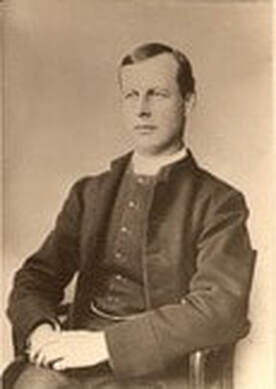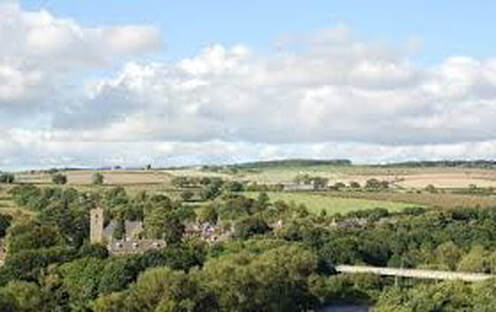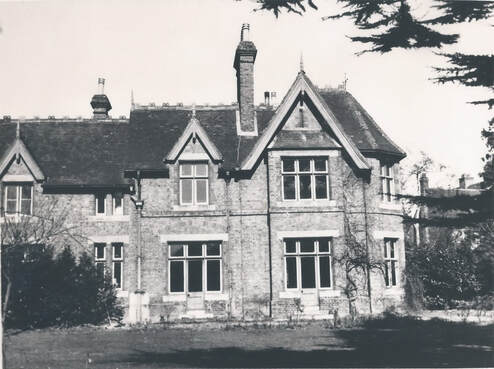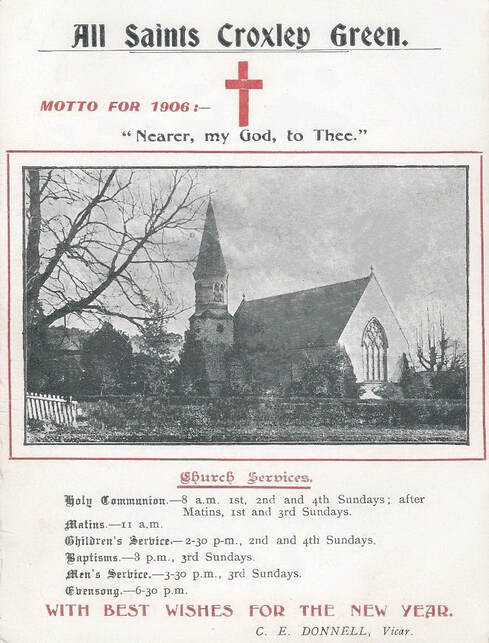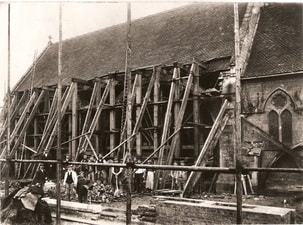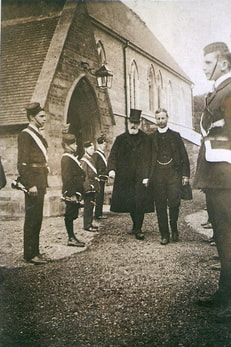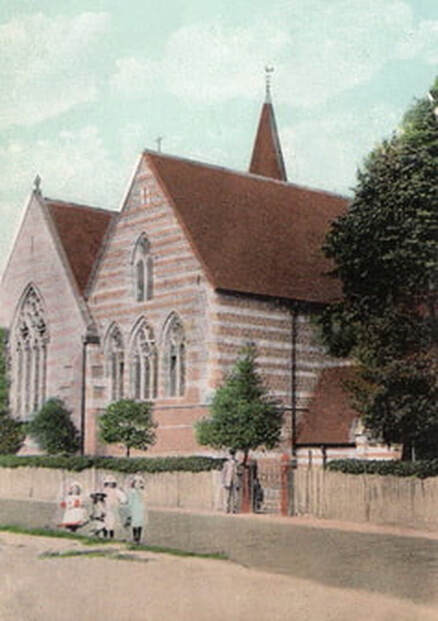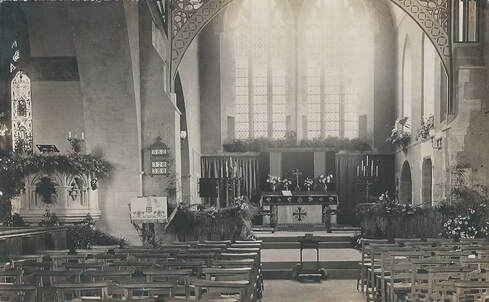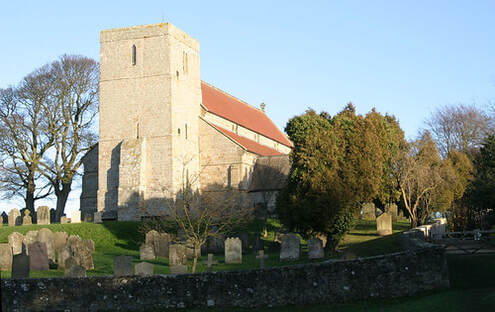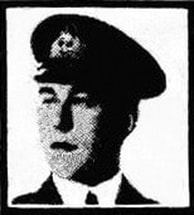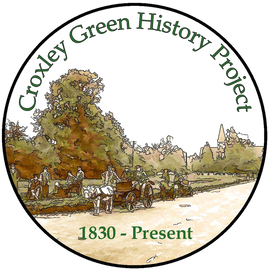Reverend Charles Ernest Havelock Donnell 1861-1930
Charles Ernest Havelock Donnell was born in January 1861 in Stalybridge, Ashton- Under- Lyne, to parents Joseph and Ann Donnell. According to the 1861 census, Joseph came from Ireland and is described as a cotton spinner and yarn merchant. The business, on the outskirts of Manchester, was right at the heart of the Industrial Revolution, contributing to this area becoming the leading producer of cotton and textiles.
From 1880 to 1884, Charles studied at Christ Church, Oxford for a Bachelor of Arts degree. His family were living at The Mount, Tarvin, Chester. Following his time at university, Charles’ whereabouts are uncertain. However, in 1891 Charles was vicar of St Mary the Virgin, Ovingham, Northumberland. The following year he married Ada Pauline Chappe Booker on 25th February in Swinton, Lancashire.
Whilst living in Ovingham they had six children: Aileen Louise, Ernest Tudor, Pauline Marguerite, Francis Chappe, Arthur Patrick and Reginald Havelock.
From 1880 to 1884, Charles studied at Christ Church, Oxford for a Bachelor of Arts degree. His family were living at The Mount, Tarvin, Chester. Following his time at university, Charles’ whereabouts are uncertain. However, in 1891 Charles was vicar of St Mary the Virgin, Ovingham, Northumberland. The following year he married Ada Pauline Chappe Booker on 25th February in Swinton, Lancashire.
Whilst living in Ovingham they had six children: Aileen Louise, Ernest Tudor, Pauline Marguerite, Francis Chappe, Arthur Patrick and Reginald Havelock.
Charles and Ada came to Croxley Green with their family in 1899. He was the second vicar of All Saints church, taking over from the Rev. Astley Roberts.
Charles settled into village life, and in an article from the new Parish Magazine he had introduced in January 1900, Charles wrote:
January
My dear Parishioners,
I have taken the liberty of introducing with the beginning of another year a new magazine into the Parish, and hope the one selected will be found interesting, and that those who formerly took the Banner of Faith will not find that they have lost in the change; I also hope that, as time goes on, many more people will take the Parish Magazine.
A Vicar of a Parish has often some information about Church and Parochial matters which he desires to communicate, news of this kind, and also perhaps other items of local interest will be printed on the inside of the cover. While I shall be always glad to receive any comments on subjects or letters printed in the parish part of the Magazine, and will, as far as space allows, publish them if desired. I wish it to be understood that I shall not reply to any such comments that may appear in the public press.
In this short letter, there are just two points I wish to speak about. As it seems a little hard that those whose work it is to teach throughout the week, should be left to supply the teaching also on Sunday, I venture to appeal to those who have some more leisure in the week, or who are engaged in entirely different work, to undertake some work of this kind on Sunday.
I need not of course add, that any day school teachers who will make the sacrifice of teaching on Sunday also will be most gladly welcomed still.
The Sunday School will open at 10.10 a.m., thus allowing 5 minutes for opening school and marking registers, and half an hour for teaching, the children leaving for church at 10.45 a.m. On the 2nd and 4th Sundays in the month, catechism in church will take the place of afternoon school.
Secondly as regards the Services in Church; I would appeal to the congregation to join as much as possible in the singing, the choir will, I am sure, do their true part that of leading and helping the congregation. The service of Praise ought to be hearty and general, and I am sure, when it becomes so many that are now conspicuous by their absence will gladly find their way to church.
I will conclude with wishing you all a bright and happy year which, if not free of all trouble and sorrow, may at any rate be full of blessings both spiritual and temporal, to ensure which neither prayer nor work will be spared by
Your affectionate Vicar, C.E. Donnell.
The monthly Parish Magazine was successful in documenting the activities around the church and the village. Later in the year a report regarding the annual Sunday School trip would be a visit to the Zoo at Regents Park, London. It was intended to take over one hundred children by train from Rickmansworth Metropolitan station to St. John’s Wood. However, nearer to the time, with the temperature at 88% in the shade, it was decided impracticable to take the youngest children. Instead they were entertained in the Vicarage gardens with cake, fruits and milk. The actual visit to the Zoo was very successful, at a cost of £13 12s 9d.
Charles would take the opportunity to make requests for all things church related, to boost the interior of the church. Charles and Ada’s seventh child, Frieda Gertrude, was born in 1901 at the vicarage, a large residence that clearly accommodated their large family.
January
My dear Parishioners,
I have taken the liberty of introducing with the beginning of another year a new magazine into the Parish, and hope the one selected will be found interesting, and that those who formerly took the Banner of Faith will not find that they have lost in the change; I also hope that, as time goes on, many more people will take the Parish Magazine.
A Vicar of a Parish has often some information about Church and Parochial matters which he desires to communicate, news of this kind, and also perhaps other items of local interest will be printed on the inside of the cover. While I shall be always glad to receive any comments on subjects or letters printed in the parish part of the Magazine, and will, as far as space allows, publish them if desired. I wish it to be understood that I shall not reply to any such comments that may appear in the public press.
In this short letter, there are just two points I wish to speak about. As it seems a little hard that those whose work it is to teach throughout the week, should be left to supply the teaching also on Sunday, I venture to appeal to those who have some more leisure in the week, or who are engaged in entirely different work, to undertake some work of this kind on Sunday.
I need not of course add, that any day school teachers who will make the sacrifice of teaching on Sunday also will be most gladly welcomed still.
The Sunday School will open at 10.10 a.m., thus allowing 5 minutes for opening school and marking registers, and half an hour for teaching, the children leaving for church at 10.45 a.m. On the 2nd and 4th Sundays in the month, catechism in church will take the place of afternoon school.
Secondly as regards the Services in Church; I would appeal to the congregation to join as much as possible in the singing, the choir will, I am sure, do their true part that of leading and helping the congregation. The service of Praise ought to be hearty and general, and I am sure, when it becomes so many that are now conspicuous by their absence will gladly find their way to church.
I will conclude with wishing you all a bright and happy year which, if not free of all trouble and sorrow, may at any rate be full of blessings both spiritual and temporal, to ensure which neither prayer nor work will be spared by
Your affectionate Vicar, C.E. Donnell.
The monthly Parish Magazine was successful in documenting the activities around the church and the village. Later in the year a report regarding the annual Sunday School trip would be a visit to the Zoo at Regents Park, London. It was intended to take over one hundred children by train from Rickmansworth Metropolitan station to St. John’s Wood. However, nearer to the time, with the temperature at 88% in the shade, it was decided impracticable to take the youngest children. Instead they were entertained in the Vicarage gardens with cake, fruits and milk. The actual visit to the Zoo was very successful, at a cost of £13 12s 9d.
Charles would take the opportunity to make requests for all things church related, to boost the interior of the church. Charles and Ada’s seventh child, Frieda Gertrude, was born in 1901 at the vicarage, a large residence that clearly accommodated their large family.
The village activities were well documented and were organised by many of the influential residents including Mrs Donnell. The Church Lads Brigade, Band of Hope as well as the Dickinson’s Institute were often mentioned in the Parish Magazine.
As a ‘church school’ it was the role as vicar, to became involved with the two village schools, Yorke Road and the boys’ school in the Watford Road. Charles would make regular visits testing the children on their knowledge of the Bible, and would be very pleased also, when the visits from the St. Albans Diocesan Inspector was favourable. He was also very concerned that all the children received a good education.
In the Parish Magazine for March 1902, Charles wrote:
There is, however, another matter to which I would direct the attention of Parents. The attendance at our Day Schools is very far below what it ought to be, and compares very unfavourably with neighbouring Schools. There seems no reason why children in Croxley should not be able to attend school as regularly as children in Watford – the distances our children have to come are not great, and surely Croxley is as healthy as Watford, we presume that mothers in Watford have their washing days, the same as mothers here. Why should the average attendance be so much lower? It cannot be that parents do not value education, and I should hope it cannot be because they need a greater application of force.
As it is, The Education of the children suffers; The Teachers do not have a fair chance, and The School suffers financially, the Grants for the past year, with a good attendance would have been at least £50 more than they will be.
Charles was a member of the village planning committee as chairman for organising the sports events to celebrate the 1902 coronation of Edward VII. He was also instrumental in suggesting that the John Dickinson paper mill form a rifle club, outlining his proposals at a meeting held in the Dickinson Institute on 7th February 1903.
The recently appointed headmaster of the boys’ school, Neggy Wilson, introduced the boys
to cricket with the intention of forming a team. Caius College, Cambridge, who owned The Green at that time, gave permission for its use as a cricket field. A suitable site was identified and a rough cricket ‘square’ was marked out. Gradually this area was improved and eventually formed a playable ‘square’. Charles assisted with cricket lessons after school, between 4pm and 5pm and those boys not involved in swimming lessons were asked to lend a hand with mowing the cricket field. Weather permitting, the boys were regularly tasked with treating the grass. Much rolling and mowing was inevitably required. As punishment for misbehaving in school, boys were often sent to weed the pitch using their penknives.
As well as the younger children having a yearly treat this was extended to the older residents too.
In 1903 it was discussed that many old people had never seen the sea! A trip to Brighton for elderly residents between the ages of 55 years and 70 years who submitted their names was organised for June 18th The railway fare would be paid for, and they were expected to bring their own food. The train left Watford Junction at 5.5am and transport from the village would be available to the station. Expected return would be 10pm.
As a ‘church school’ it was the role as vicar, to became involved with the two village schools, Yorke Road and the boys’ school in the Watford Road. Charles would make regular visits testing the children on their knowledge of the Bible, and would be very pleased also, when the visits from the St. Albans Diocesan Inspector was favourable. He was also very concerned that all the children received a good education.
In the Parish Magazine for March 1902, Charles wrote:
There is, however, another matter to which I would direct the attention of Parents. The attendance at our Day Schools is very far below what it ought to be, and compares very unfavourably with neighbouring Schools. There seems no reason why children in Croxley should not be able to attend school as regularly as children in Watford – the distances our children have to come are not great, and surely Croxley is as healthy as Watford, we presume that mothers in Watford have their washing days, the same as mothers here. Why should the average attendance be so much lower? It cannot be that parents do not value education, and I should hope it cannot be because they need a greater application of force.
As it is, The Education of the children suffers; The Teachers do not have a fair chance, and The School suffers financially, the Grants for the past year, with a good attendance would have been at least £50 more than they will be.
Charles was a member of the village planning committee as chairman for organising the sports events to celebrate the 1902 coronation of Edward VII. He was also instrumental in suggesting that the John Dickinson paper mill form a rifle club, outlining his proposals at a meeting held in the Dickinson Institute on 7th February 1903.
The recently appointed headmaster of the boys’ school, Neggy Wilson, introduced the boys
to cricket with the intention of forming a team. Caius College, Cambridge, who owned The Green at that time, gave permission for its use as a cricket field. A suitable site was identified and a rough cricket ‘square’ was marked out. Gradually this area was improved and eventually formed a playable ‘square’. Charles assisted with cricket lessons after school, between 4pm and 5pm and those boys not involved in swimming lessons were asked to lend a hand with mowing the cricket field. Weather permitting, the boys were regularly tasked with treating the grass. Much rolling and mowing was inevitably required. As punishment for misbehaving in school, boys were often sent to weed the pitch using their penknives.
As well as the younger children having a yearly treat this was extended to the older residents too.
In 1903 it was discussed that many old people had never seen the sea! A trip to Brighton for elderly residents between the ages of 55 years and 70 years who submitted their names was organised for June 18th The railway fare would be paid for, and they were expected to bring their own food. The train left Watford Junction at 5.5am and transport from the village would be available to the station. Expected return would be 10pm.
With the expansion of the John Dickinson paper mill, the population of Croxley Green was growing and it became a struggle to seat the congregation. A meeting was held in Waterdell House on 20th September 1906, where Charles and the churchwardens discussed plans for an extension to the church. Plans were agreed, and during the construction of the building in 1907, church services took place in the Boys’ School as well as the Dickinson Institute. When completed the new nave and chancel were consecrated on Saturday, May 23rd 1908.
Charles continued to play an active role in village life, but by 1913 he had decided to move back north again. He was appointed vicar of St Mary the Virgin in the village of Stamfordham, near Hexham in Northumberland, not a great distance from Ovingham, where he had lived soon after his marriage.
World War One began the following year and Charles and his family, along with many families throughout the country, were to experience huge personal tragedy. Two of Charles’ sons were killed. Ernest Tudor had joined the Royal Navy on 15th January 1907. He was a Lieutenant on H.M.S. Shark at the Battle of Jutland when his ship was sunk on 31st May 1916. He is commemorated on the Portsmouth Naval Memorial, Hampshire
Arthur Patrick, a Second Lieutenant, was in the Royal Flying Corps, 59th Squadron. He was flying a AW FK3 5540 Armstrong- Whitworth 2- seater military bi-plane when he was killed on 5th December 1916. He is buried in All Saints, churchyard, Narborough, Norfolk.
Charles passed away aged 69 in Northumberland on 17th October 1930 and Ada in 1949.
Sources
Census 1861-1911
www.ancestry.co.uk
www.familysearch.org
www.myheritage.com
www.alumni.ox.ac.uk
Kellys Directories.
Post Office Directory.
Register of Marriages, St Peter’s church, Swinton.
WW1 Records.
All Saints church archives
Charles passed away aged 69 in Northumberland on 17th October 1930 and Ada in 1949.
Sources
Census 1861-1911
www.ancestry.co.uk
www.familysearch.org
www.myheritage.com
www.alumni.ox.ac.uk
Kellys Directories.
Post Office Directory.
Register of Marriages, St Peter’s church, Swinton.
WW1 Records.
All Saints church archives
